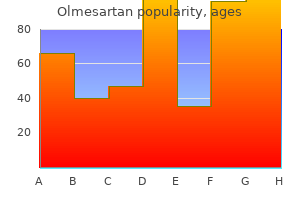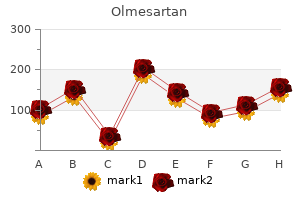Olmesartan
"Generic olmesartan 20mg visa, heart attack remix".
By: A. Candela, M.A., M.D., M.P.H.
Co-Director, Boonshoft School of Medicine at Wright State University
A child may be burned from contact with hot liquids arrhythmia jet buy generic olmesartan canada, hot objects or direct flames blood pressure chart bpm buy olmesartan with amex. Burns caused by hot liquids can have characteristic patterns when a toddler pulls a pot of hot liquid down or when someone pours a liquid over them blood pressure and headaches buy 20mg olmesartan with mastercard. The areas touched first receive the hottest liquid and the deepest burn blood pressure chart english buy olmesartan toronto, and those further down are less severely burned as the liquid cools. The child is held in hot liquid that creates burn lines where there are clear lines of demarcation of spared and burned areas. Limbs that are immersed have a demarcation that gives a stocking or glove pattern. Toddlers may walk into a cigarette but these burns are not as deep and they are usually a single burn on the face or hands. Multiple cigarettes burns or burns located on the back, chest or legs are consistent with child abuse. Bruising due to bleeding disorders like hemophilia, or platelet disorders, Henoch-Schonlein purpura, or Mongolian birthmarks have been misdiagnosed as inflicted injuries. Fractures may be due osteopenia in disabled children, and occult forms of osteogenesis imperfecta can be associated with pathologic fractures and bruising. Children can be subject to numerous physical injuries but head trauma is the most common cause of death. The injuries can be due to direct impact or from acceleration and deceleration injuries. Patients can then develop extracerebral bleeding due to tearing of bridging vessels causing subdural and/or subarachnoid bleeding. Cerebral edema often develops and may be the result of anoxia, poor perfusion, and/or direct tissue injury. While the areas of bleeding may be small on imaging studies, this does not reflect the degree of cerebral injury which is often substantial. Neurosurgical evacuation of hemorrhage does not repair cerebral cellular and axonal injury. These injuries are more common in infants and are the result of shaking battered child syndrome (also called shaken baby syndrome). Infants are more susceptible to these types of injuries due to the higher water content of the brain, poor neck control, proportionally larger head size, and more demyelinated nerve cells. The outcome of these injuries can result in brain death, cerebral atrophy, and chronic subdural collections. These children may remain in a coma, have developmental delays, seizure disorders, blindness and/or deafness (11). There is usually minimal or no history of trauma and the spectrum of clinical signs range from poor feeding, vomiting, seizures to complete cardiopulmonary arrest. The symptoms are the result of intracranial injuries which may include subdural hemorrhage and/or subarachnoid hemorrhage, cerebral edema and shearing injuries to brain cells (12). Their intracranial injuries are associated with retinal hemorrhages and sometimes with long bone fractures or rib fractures. Since victims of shaken baby and other forms of child abuse can present with various signs and symptoms that at first glance may not suggest intentional trauma, the practitioner must have a high index of suspension and include child abuse in the differential diagnosis. Abdominal injuries are most likely due to blunt trauma and can result in hematoma or laceration of the pancreas, duodenum and or the jejunum. These injuries can lead to hypotension, abdominal distention, vomiting, and ileus. Blunt abdominal trauma may also result in visceral rupture to organs such as the liver, spleen pancreas, or major abdominal vessels. These children present very ill in shock with significant hemorrhaging, hypotension and possibly a full cardiopulmonary arrest. Determining whether injuries sustained by infants and children are due to abuse or accident, can be difficult. The clinician should be alert to histories that do not adequately explain the injuries.
Syndromes
- Increased thirst
- Sensations of an object in the ear
- This means precancerous changes are likely to be present
- Milk
- Retinal detachment
- Ask your health care provider about using a soft neck collar to relieve discomfort. Do not use the collar for a long time. Doing so can make your neck muscles weaker.
- Decreased motion of the shoulder joint
- Gerd causes a chronic cough or hoarseness in your child.
- Skin debridement (surgical removal of burned skin)

Quality of life on angina therapy: a randomised controlled trial of transdermal glyceryl trinitrate against placebo arteria spinalis anterior generic olmesartan 40 mg overnight delivery. A controlled randomized study of early cardiac rehabilitation: the Sickness Impact Profile as an assessment tool hypertension first aid purchase olmesartan paypal. Comparative measurement efficiency and sensitivity of five health status instruments for arthritis research class 1 arrhythmia drugs buy olmesartan 20 mg overnight delivery. The development and application of indices of health: general methods and a summary of results blood pressure chart explained purchase olmesartan 40mg free shipping. Health-related quality-of-life measurement for evaluation research and policy analysis. Quality-of-life after myocardial infarction: effect of long term metoprolol on mortality and morbidity. Comparison of clinical dyspnea ratings and psychophysical measure- ments of respiratory sensation in obstructive airway disease. Analysis of Quality of Life data from a Randomized, Placebo controlled Heart-Failure trial. Impact on quality of life assessed by traditional standard-item and individualized patient preference health status questionnaires. The use of generic and specific quality-of-life measures in hemodialysis patients treated with erythropoietin. Responding to this heterogeneity of treatment effect, psychological research has long taken advantage of experimental studies of single subjects. In this chapter, we describe how clinicians can use an experimental approach that focuses on the individual to facilitate clinical research and, especially, to enhance the clinical care of their patients. We believe the approaches we describe are highly relevant to pharmacoepidemiology Pharmacoepidemiology, Third Edition. First, if the patient does not meet the eligibility criteria, extrapolation may not be appropriate. Under these circumstances, clinicians typically conduct the time-honored ``trial of therapy,' in which the patient is given a treatment and the subsequent clinical course determines whether the treatment is judged effective and continued. However, many factors may mislead physicians conducting conventional therapeutic trials. They include the placebo effect, the natural history of the illness, the expectations that the clinician and patient have about the treatment effect, and the desire of the patient and the clinician not to disappoint one another. To avoid these pitfalls, clinicians must conduct trials of therapy with safeguards that keep both patients and themselves ``blind' to the treatment being administered. To implement these safeguards in a clinically sensible manner while investigating drug effects in the individual patient constitutes a considerable challenge. The third is to choose appropriate treatment targets to monitor the effects of therapy (both beneficial and potentially harmful). The trial continues as long as the clinician and patient agree that they need more information to obtain a definite answer regarding the efficacy, superiority, or side-effects of the treatment, or until the patient or clinician decide for any other reason to end the trial. If a very short duration of treatment periods is feasible, the number of pairs could be greater. In addition to the effectiveness or harmful side-effects of treatment being in doubt, the disorder should be relatively chronic and stable. The treatment(s) must have a rapid onset and termination of action, and the clinician should be aware of the optimal treatment duration, which must be practical. Last but not least, the clinician must secure the cooperation of a pharmacy in the preparation of blinded medication. Let us assume that the problem with which the clinician is faced is new onset of pain associated with walking (intermittent claudication) in a patient with peripheral vascular disease and a previous myocardial infarction. This patient began taking -blockers some time ago to prevent a recurrent myocardial infarction. Now the clinician reads the insert to the -blocker and confirms what she remembers from medical school: -blockers may exacerbate the symptoms of peripheral vascular disease. She then finds a meta-analysis that concludes that -blockers do not have this effect.
Discount 10mg olmesartan fast delivery. CNA Skills: Taking a Blood Pressure.

There are individual differences in responses to marijuana that are affected by a variety of factors arterial blood gas cheap 40mg olmesartan overnight delivery. Many people report using marijuana to cope with anxiety hypertension questions purchase 20 mg olmesartan mastercard, and this may be particularly common among those with social anxiety disorder blood pressure under 60 order olmesartan 20mg mastercard. Those who are concerned about marijuana increasing anxiety are unlikely to use it whereas those who use it and find it to be beneficial presumably continue to use marijuana blood pressure chart homeostasis buy olmesartan discount. Doing so may offer some benefit in the short term, at least in terms of anxiety, but well-controlled studies indicate that use of marijuana is associated with increased likelihood of substance use disorders in the future. Prevalence of marijuana use disorders in the United States between 2001-2002 and 2012-2013. A tale of two cannabinoids: the therapeutic rationale for combining tetrahydrocannabinol and cannabidiol. A Cross-sectional survey of medical cannabis users: Patterns of use and perceived efficacy. A positive association between anxiety disorders and cannabis use or cannabis use disorders in the general population-a meta-analysis of 31 studies. Association of cannabis use with the development of elevated anxiety symptoms in the general population: a meta-analysis. Specificity of social anxiety disorder as a risk factor for alcohol and cannabis dependence. The impact of comorbid cannabis use disorders on the clinical presentation of social anxiety disorder. Article title: "Depression and anxiety during 2019 coronavirus disease pandemic in Saudi Arabia: a crosssectional study". Department of Mathematics, Faculty of Science, Al Albayt University, Al Mafraq, Jordan. Department of Pharmaceutics, College of Pharmacy, King Saud University, Riyadh, Saudi Arabia. Alyami, Assistant Professor in Drug Delivery, Department of Pharmaceutics, College of Pharmacy, Najran University, Najran, Saudi Arabia, hsalmukalas@nu. Methods: A cross-sectional study using an online survey was conducted in Saudi Arabia between 27th of March and 27th of April 2020. Logistic regression analysis was used to identify predictors of depression and anxiety. Results: the prevalence of depression and anxiety among the entire study participants was 9. Policymakers and mental healthcare providers are advised to provide continuous monitoring of the psychological consequences during this pandemic, and provide mental support. After the first confirmed case, the Saudi Arabian government announced series of extreme measures to control the spread of the virus beginning by panned all transport in and out of the Qatif Governorate on March 8, and most recently on April 6, to announcing a 24-hour curfew implemented in the major cities with movement restricted to only essential travel between 6 a. The extremely proactive measures taken to prevent the spread of the virus could contribute to provoking public fear, anxiety and/or depression, which is usually neglected during crisis and pandemic management [8-12]. Sampling strategy A convenience sample of eligible participants was invited to participate in the study. The general population was invited to participate in this study through social media (Facebook and WhatsApp). All participants voluntarily participated in the study and were thus considered exempt from written informed consent. The study aims and objectives were clearly explained at the beginning of the survey. The inclusion criteria were: a) participants aged 18 years and above and living currently in Saudi Arabia, and b) participants who had no apparent cognitive deficit. Participants were excluded if they were: a) below 18 years of medRxiv preprint doi: doi. These screening instruments were frequently used and validated as brief screening tools among various populations for depression and anxiety [13-17]. The prevalence rate of depression was estimated by dividing the number of participants who exceeded the borderline score (15) by the total number of participants in the same population.
Diseases
- Yunis Varon syndrome
- Goldblatt Viljoen syndrome
- Exudative retinopathy familial, autosomal dominant
- Primary malignant lymphoma
- Psychophysiologic disorders
- Hypogonadism mitral valve prolapse mental retardation
- Peripartum cardiomyopathy
- Neuraminidase beta-galactosidase deficiency

